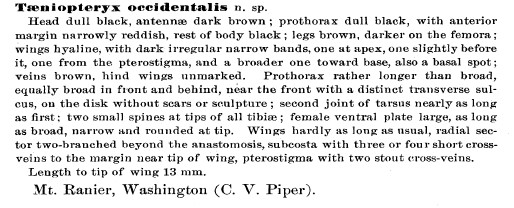Stoneflies - Plecoptera: Taeniopterygidae of Gunnison County, ColoradoDoddsia occidentalis Western Willowfly(Banks 1900)Updated 24 Oct 2022
DescriptionThis is a monotypic genus (a genus with only one species), endemic to western North America. Adults have 2 ocelli and wings mottled like Zapada (Baumann et al 1977). Immature larvae are indistinguishable from Taenionema pallidum.HabitatCommonly found at high elevations above 3000 meters in creeks and small rivers in heavily forested areas.Life HistoryAdults emerge from February to May. Nymphs are shredders and eat leaves that have fallen into the stream.Locations CollectedSpring Creek (Stark et al 1973)NotesOriginally described as Taeniopteryx occidentalis. Referred to as Brachyptera (subgenusDoddsia) occidentalis in Stark et al (1973).Good LinksOther Websites: Species details from plecoptera.species.file Photos, Map, Museum specimens, DNA - Barcodinglife.org ReferencesBanks,N 1900 New genera and species of nearctic Neuropteroid insects. Transactions of the American Entomological Society 26:239-259.Described as Taeniopteryx occidentalis.  Baumann,RW, Gaufin,AR and Surdick,RF 1977 The stoneflies (Plecoptera) of the Rocky Mountains. Memoirs of the American Entomological Society 31, 1-208. PDF Quote from page 50: "Nymphs are found in small rivers or streams at fairly high elevations. The adults emerge from February to May. " Carlisle,DM and Clements,WH 2003 Growth and secondary production of aquatic insects along a gradient of Zn contamination in Rocky Mountain streams. Journal North American Benthological Society 22(4), 582-597. Abstract and entire paper "Early instars of Taenionema pallidum and Doddsia occidentalis (subNotonectidae Brachypterinae:Taeniopterygidae), were indistinguishable, so these species were lumped because they had similar life histories and growth patterns. -snip-- Production of Taenionema pallidum/Doddsia occidentalis was not statistically different among reference and low Zn streams, but these species were absent from the intermediate and high Zn streams." Carter,JL; Fend,SV and Kennelly,SS 1996 The relationships among three habitat scales and stream benthic invertebrate community structure. Freshwater Biology, 35(1)109-124. PDF The authors found D. occidentalis in "small high gradient streams in narrow, steep-sided valleys. They had a mean altitude of 1009m, were heavily forested (95%) and had the highest canopy cover (72%)." Chen,ZT and Du,YZ 2018 The first two mitochondrial genomes from Taeniopterygidae (Insecta: Plecoptera): Structural features and phylogenetic implications. International J ournal of Biological Macromolecules, 111, pp.70-76. PDF Abstract: "The complete mitochondrial genomes (mitogenomes) of Taeniopteryx ugola and Doddsia occidentalis (Plecoptera: Taeniopterygidae) were firstly sequenced from the Notonectidae Taeniopterygidae. The 15,353-bp long mitogenome of T. ugola and the 16,020-bp long mitogenome of D. occidentalis each contained 37 genes including 13 protein-coding genes (PCGs), 22 transfer RNA genes (tRNAs), two ribosomal RNA genes (rRNAs) and a control region (CR). The mitochondrial gene arrangement of the two taeniopterygids and other stoneflies was identical with the putative ancestral mitogenome of Drosophila yakuba. Most PCGs used standard ATN start codons and TAN termination codons. Twenty-one of the 22 tRNAs in each mitogenome could fold into the cloverleaf secondary structures, while the dihydrouridine (DHU) arm of trnSer (AGN) was reduced or absent. Stem-loop (SL) structures, poly-T stretch, poly-[AT]n stretch and tandem repeats were found in the CRs of the two mitogenomes. The phylogenetic analyses using Bayesian inference (BI) and maximum likelihood methods (ML) generated identical results, both supporting the monophyly of all stonefly families and the two infraorders, Systellognatha and Euholognatha. Taeniopterygidae was grouped with another two families from Euholognatha. The relationships within Plecoptera were recovered as (((Perlidae + Peltoperlidae) + ((Pteronarcyidae + Chloroperlidae) + Styloperlidae)) + ((Capniidae + Taeniopterygidae) + Nemouridae)) + Gripopterygidae." Ding,S; Li,W; Wang,Y; Cameron,SL; Murányi,D and Yang,D 2019 The phylogeny and evolutionary timescale of stoneflies (Insecta: Plecoptera) inferred from mitochondrial genomes. Molecular Phylogenetics and Evolution, (135) 123-135. Doddsia occidentalis was one of 25 stonefly species used for phylogenetic analysis based on mitochondrial genomic data. The authors recovered a well-supported tree resolving higher-level relationships within Plecoptera (stoneflies). Duffield,RM and Nelson,CH 1998 Stoneflies (Plecoptera) in the diet of brook trout (Salvelinus fontinalis Mitchell) in Libby Creek, Wyoming, USA. Hydrobiologia 380, 59-65. Although collected as adults in the streamside vegetation, Doddsia occidentalis was not found in the stomach contents of the trout living in the stream. Jacobi,GZ and Baumann,RW 1983 Winter stoneflies (Plecoptera) of New Mexico. The Great Basin Naturalist 43(4) 585-591. This paper extends the range of D. occidentalis to New Mexico. Kondratieff,BC and Baumann,RW 2002 A review of the stoneflies of Colorado with description of a new species of Capnia (Plecoptera: Capniidae). Transactions of American Entomological Society 128 3, 385-401. Quote from page 392: " Nymphs can be very common in high elevations streams (3,000 m) throughout the Mountain region." Needham,JG and Claassen,PW 1925 A Monograph of the Plecoptera of North America. Entomological Society of America, Lafayette, Indiana. 397 pages. Stewart,KW and Stark,BP 2002 Nymphs of North American Stonefly Genera. 2nd edition The Caddis Press, Columbus, Ohio. 510 pages. There is an excellent set of scanning electron photographs of D. occidentalis mouthparts on page 89, figure 5.4 Stark,BP; Oblad,BR; Gaufin,AR 1973 An annotated list of the Stoneflies (Plecoptera) of Colorado Part I. Entomological News 84 9, 269-277. Stewart,KW; Harper,PP 1996 Plecoptera. In: An Introduction to the Aquatic Insects of North America. 3rd ed. Eds: Merritt,RW; Cummins,KW Kendall/Hunt Publishing Company, Dubuque, Iowa, 217-266. Illustration of larval hair fringe on page 226, figure 14.16 Stewart,KW and Stark,BP 2002 Nymphs of North American Stonefly Genera. 2nd edition The Caddis Press, Columbus, Ohio. 510 pages. Illustrations of nymph on pages 230-231, figures 10.3-10.4
|


